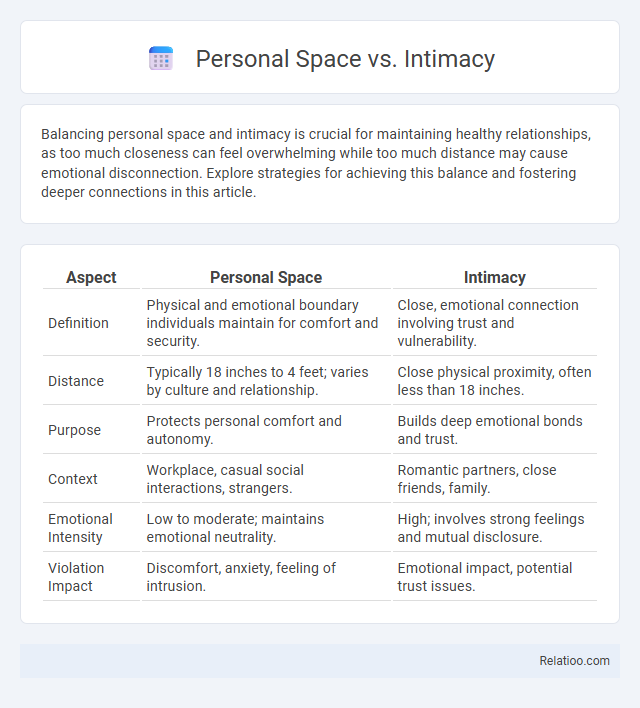Balancing personal space and intimacy is crucial for maintaining healthy relationships, as too much closeness can feel overwhelming while too much distance may cause emotional disconnection. Explore strategies for achieving this balance and fostering deeper connections in this article.
Table of Comparison
| Aspect | Personal Space | Intimacy |
|---|---|---|
| Definition | Physical and emotional boundary individuals maintain for comfort and security. | Close, emotional connection involving trust and vulnerability. |
| Distance | Typically 18 inches to 4 feet; varies by culture and relationship. | Close physical proximity, often less than 18 inches. |
| Purpose | Protects personal comfort and autonomy. | Builds deep emotional bonds and trust. |
| Context | Workplace, casual social interactions, strangers. | Romantic partners, close friends, family. |
| Emotional Intensity | Low to moderate; maintains emotional neutrality. | High; involves strong feelings and mutual disclosure. |
| Violation Impact | Discomfort, anxiety, feeling of intrusion. | Emotional impact, potential trust issues. |
Understanding Personal Space and Intimacy
Understanding personal space involves recognizing the physical and emotional boundaries that maintain comfort and autonomy, which varies from person to person. Intimacy requires a deeper connection where trust allows vulnerability without fear of judgment or breach, fostering emotional closeness. You can strengthen relationships by respectfully balancing personal space with moments of shared intimacy, building a foundation of trust.
The Psychology Behind Personal Boundaries
Personal boundaries are psychological limits established to protect individual identity and emotional well-being, playing a crucial role in managing personal space, intimacy, and trust. These boundaries help to regulate interactions, ensuring comfort and safety while facilitating healthy relational dynamics. Violations of personal boundaries can erode trust and hinder intimacy, highlighting the importance of understanding and respecting these psychological limits in relationships.
Types of Personal Space in Relationships
Personal space in relationships can be categorized into physical, emotional, and digital boundaries, each crucial for maintaining comfort and respect. Physical space involves the need for proximity or distance, influencing how partners interact daily, while emotional space relates to sharing feelings and respecting individual emotional needs. Your understanding of these types helps build intimacy and trust by honoring boundaries and fostering open communication.
Intimacy: Emotional and Physical Dimensions
Intimacy encompasses both emotional and physical dimensions, where emotional intimacy involves sharing feelings, thoughts, and vulnerabilities to create a deep connection, while physical intimacy includes touch, closeness, and affection that foster bonding. Your ability to balance personal space with these intimate moments is crucial for building and maintaining trust in relationships. Understanding and respecting boundaries in both areas enhances mutual trust and strengthens emotional connection.
Cultural Differences in Space and Intimacy
Cultural differences significantly influence perceptions of personal space, intimacy, and trust, impacting social interactions and relationships. In some cultures, close physical proximity signals warmth and trust, while others prioritize greater distance to respect personal boundaries. Understanding these variations is crucial for navigating cross-cultural communication and ensuring your interactions are respectful and comfortable for all parties involved.
Signs of Encroached Personal Space
Signs of encroached personal space include feelings of discomfort, anxiety, or agitation when someone stands too close, invading your physical boundaries without consent. Your body language may shift, such as stepping back, crossing arms, or avoiding eye contact, signaling a need for more distance. Recognizing these signs helps maintain healthy intimacy and fosters trust by respecting your spatial limits.
Building Healthy Boundaries
Establishing healthy boundaries is essential for maintaining personal space, fostering intimacy, and building trust in relationships. You can protect your emotional well-being by clearly communicating your needs while respecting others' limits, which prevents misunderstandings and promotes mutual respect. Prioritizing boundary-setting cultivates a safe environment where trust and intimacy can naturally grow.
Balancing Closeness and Independence
Balancing closeness and independence requires respecting personal space while fostering intimacy and trust. Maintaining clear boundaries allows individuals to feel safe and valued, which strengthens emotional connections without compromising autonomy. Developing open communication is essential to navigate the delicate interplay between proximity and personal freedom.
Communication Strategies for Respecting Space
Effective communication strategies for respecting personal space emphasize clear boundary setting and active listening, enabling you to understand and honor others' comfort levels. Using "I" statements helps express your needs without causing defensiveness, fostering trust and intimacy through mutual respect. Consistently recognizing nonverbal cues enhances awareness of space preferences, strengthening relationships by balancing closeness with individual autonomy.
Navigating Personal Space Issues in Modern Relationships
Navigating personal space issues in modern relationships requires understanding the distinct yet interconnected roles of personal space, intimacy, and trust. Respecting your partner's need for personal space fosters a healthy balance, allowing intimacy to deepen without overwhelming boundaries. Establishing clear communication about boundaries and expectations strengthens trust, ensuring both partners feel valued and secure.

Infographic: Personal Space vs Intimacy
 relatioo.com
relatioo.com